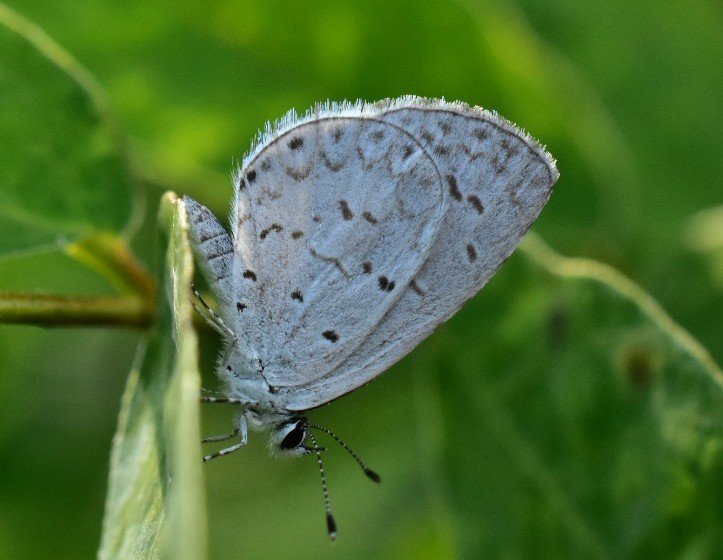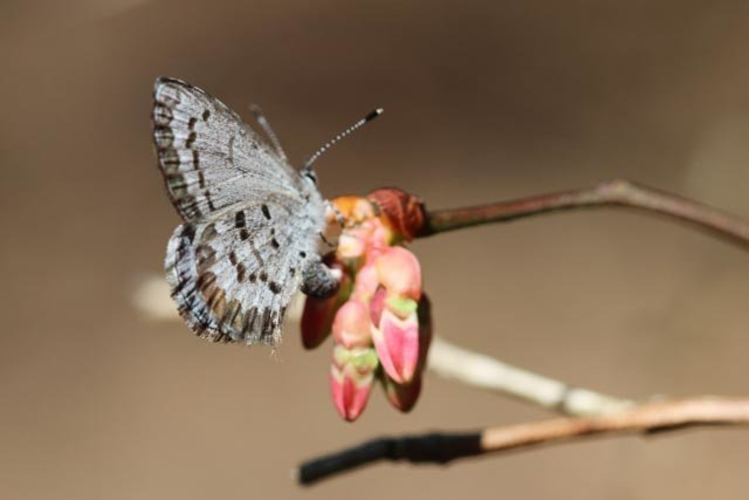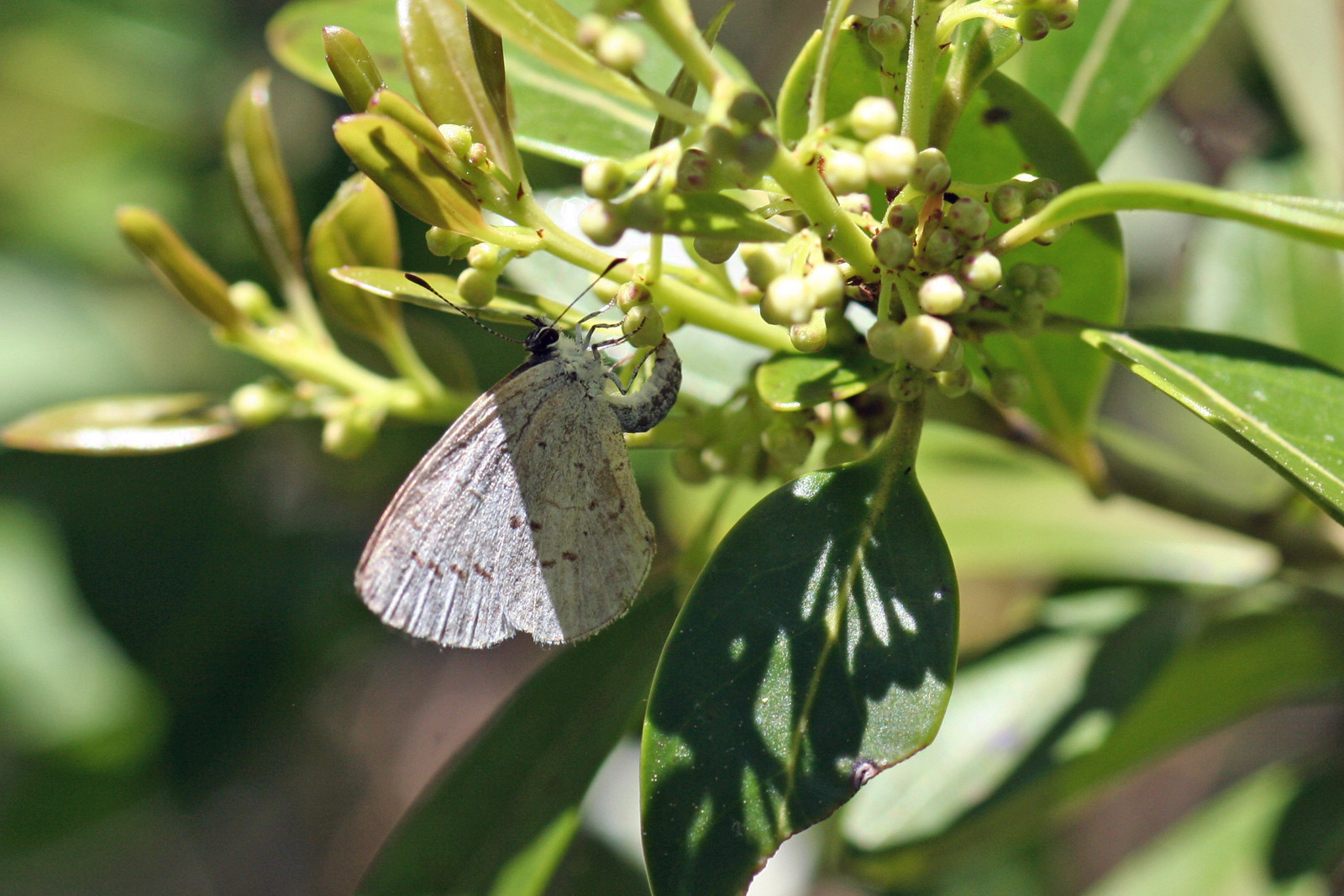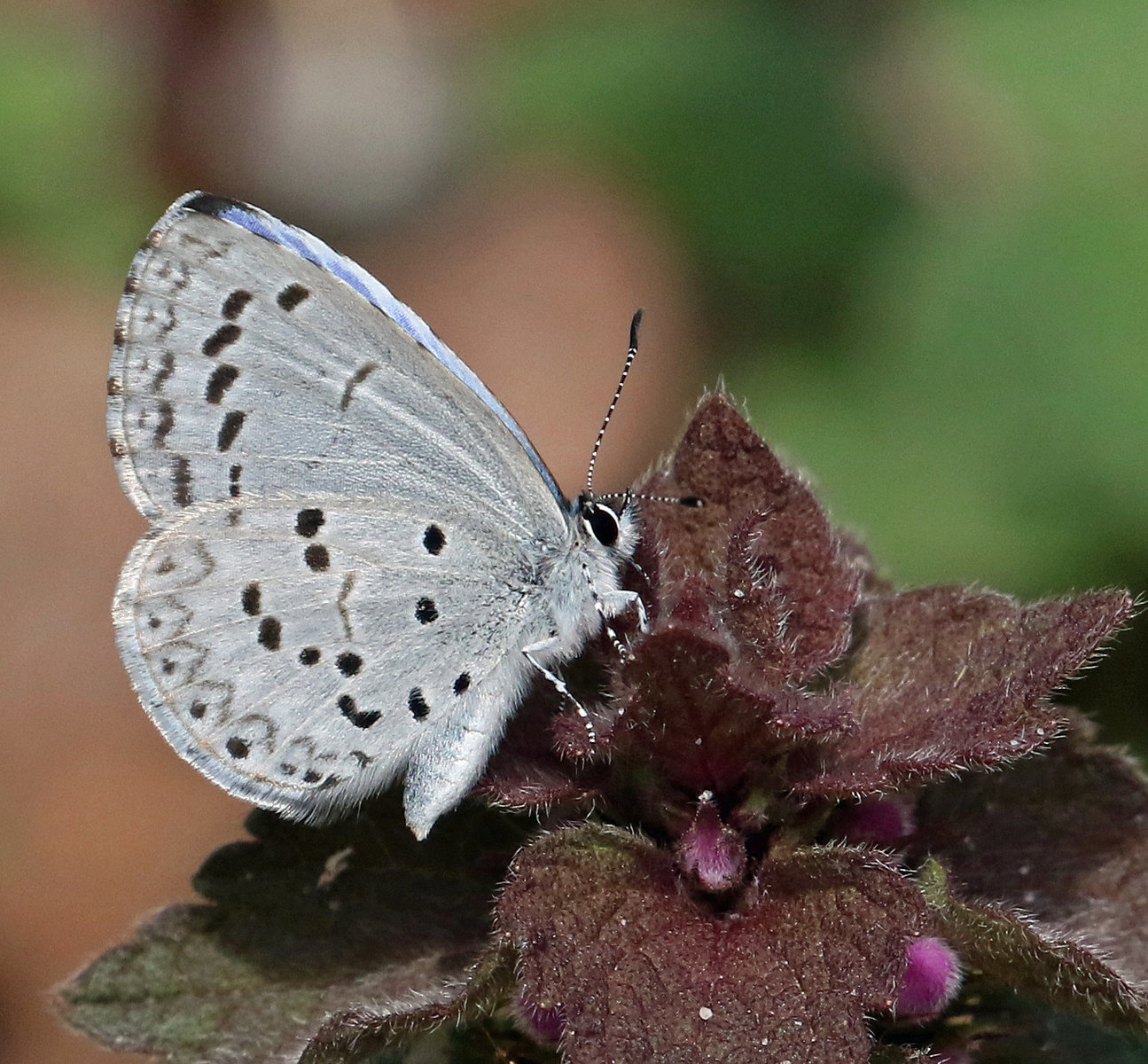
A: Don’t even try!
[This post has been updated as on 5-5-21 to include the responses of Dale Schweitzer and Wade Wander, now to be found below “Sources“ at the end of the article]
“How many different azure species are there in South Jersey?” and “How should we ID them?” are questions that seem to come up each year about this time.
Unfortunately, the most accurate answer to both questions seems to be another question: “Who knows?”
As a public service, the SJ Butterfly Project hereby offers five different ways to handle the conundrum. Choose the method that best matches your style and attitude and then take advantage of our money-back guarantee that you will sleep better forever after.
Arranged by the amount of homework required for each, our five offerings include:
- The Traditional & Simple Plan (a one-name system)
- The Simplicity-Plus Plan (a two-name system)
- The I-Love-Lucia Plan (a three-name system)
- The Holly-Go-Lightly Plan (a four-name system)
- The Welcome-To-The-Twilight-Zone Plan (an alternative four-name system)
Traditional & Simple (a one-name system):
From at least 1951 — when the Peterson Field Guide Series published A Field Guide To The Butterflies by Alexander Klots — through the 1980’s, most popular sources about butterflies and insects described a single species of “spring azure.” It was understood to be a very variable species that showed seasonal and geographical differences in coloring and a mix of host plant preferences, and it ranged from Alaska to Florida. In some areas it emerged in two or three broods and flew from early spring through summer. Its hosts included blueberries (Vaccinium), hollies (Ilex), dogwoods (Cornus), meadowsweet (Spiraea), and many others. The scientific name had changed over the decades — Klots called it Lycaenopsis argiolus — but seemed to have settled on Celastrina ladon. Opler & Krizek note in their Butterflies East Of The Great Plains (1984) that the name ladon comes from Ladon, the dragon of Greek myth with one hundred heads. Apparently, that was intended to suggest the many forms found in the species.
The various forms posed a challenge to any author trying to describe “spring azure” succinctly and clearly. Klots gave it a go with just two sentences, “The pale, slightly violet-tinged blue of the upper side is frequently, sometimes strongly, whitish on the disc, particularly on the hind wings. The underside is entirely without orange or iridescent markings and has a ‘washed-out’ look even though it may be heavily marked with brown blotches.” William Howe found Klots’ description so good that he copied it almost word for word in his Butterflies Of North America (1975).
Ok, Traditional & Simple Planners, that’s all you need to know. Now it’s time for your Exit Quiz. Name all butterflies in the following six photographs correctly, and you are excused from all further discussion immediately:
Correct! According to the Traditional & Simple Plan, they are all spring azures, Celastrina ladon!
As you leave our virtual classroom today, do not be intimidated by those folks remaining here to consider other systems. Our Traditional & Simple Plan has a solid principle at its base: Both professional and amateur lepidopterists have been using one name for all populations for more than a century. Many, probably most, still do.
One-Name System:
|
Season |
Species Name |
Common Name |
Host Plants in Southern NJ |
|
March-Sept |
Celastrina ladon |
spring azure |
Vaccinium, Cornus, Ilex, Spiraea, and other woody plants |
Simplicity-Plus (a two-name system):
We turn next to those of you who are uncomfortable calling those little blue butterflies you find in your yard in July, August and September spring azures.
The solution is our Simplicity-Plus Plan. Add a second species to your mental checklist: the summer azure. A scientific name widely recognized is Celastrina neglecta and links back to 1862 when W.H. Edwards described a summer-flying azure and gave it the species name “neglecta” because it had been so long overlooked.
How can you identify a summer azure in the simplest way possible? Wait until summer! By then blueberries, hollies, and dogwoods are long past flowering. Once those plants have set seed, any little blue butterfly you see in our area without orange below can safely be called a summer azure.
The caterpillars feed on the flower parts of Spiraea (meadowsweet) and also must feed on the flowers of other summer-blooming host plants — because, unlike all other azure forms, neglecta adults fly in multiple broods. Also unlike all others, they continue flying into late summer and even early fall. The full list of summer plants the adults use for ovipositing seems undetermined for our area, however.
But you need not worry about a host plant list to adopt our Simplicity-Plus Plan. Can you look back at our six quiz photos above and choose the butterfly you can call summer azure?
[Hint: Ignore the field marks. Read the captions. ]
Yes, Simplicity-Plus Planners, the sixth photo — taken by Lucy Hooper in her backyard — is the only one with a summer date. You have used the two-name plan successfully. On your way out of the classroom be prepared for smart-alecks in the back of the class muttering at you, “You’re ignoring the challenge and missing all the fun! Different azures use different host plants all spring!” We recommend you respond with a snappy, “I like to be sure of my IDs!”
Two-Name System
| March-May | Celastrina ladon | spring azure | Vaccinium, Cornus, Ilex, and other spring-blooming woody plants |
| June-Sept | Celastrina neglecta | summer azure | Spiraea and other summer-blooming woody plants |
The I-Love-Lucia (a three-name system):
At this point, those of you remaining are warned that azure-ID gets increasingly murky at each of the remaining three steps. Authorities disagree with each other, field marks grow uncertain, and each observer’s subjective judgment becomes a critical factor.
It could be worse. Just be grateful that our five plans focus only on the azures that have been documented in NJ’s Coastal Plain counties. Pity the poor butterflyers in Maryland, Pennsylvania, and North Jersey who (depending on where they live) might stumble upon a dusky azure (C. nigra), an Appalachian azure (C. neglectamajor), or a cherry gall azure (C. serotina).
In southern NJ it’s simpler (apparently). But you can dip just a little deeper into the complexity of azures by adding a third name to your personal checklist. This is Celastrina lucia, the blueberry azure, a.k.a. the northern azure.
The idea that the northernmost populations of azures might represent a separate species of butterfly dates back to 1837, when William Kirby, collecting insects in Saskatchewan, named the azures he had netted there Polyommatus lucia. For an excellent review of the many name changes since Kirby’s discovery and their different interpretations across North America, see “A Short Discussion Of Celastrina lucia” in Wright and Pavulaan (2005) at the end of this post.
For South Jersey purposes the key message from that review is, “Recent reappraisals by Wright (1998), Nielsen (1999), Ochlenschlager& Huber (2002), and Opler & Warren (2002) have returned C. lucia (Kirby) to a full species.”

The most distinctive feature of lucia is its close association with blueberry plants, Vaccinium. Their annual emergence is timed to enable the adults to mate and lay eggs on the buds of blueberries, so that their caterpillars can consume the flower parts as the buds open. Unlike most butterfly species, but like all other azures, the caterpillars do not eat the leaves of their host plants. By the time blueberry leaves are fully open, the pupae of lucia are buried in the soil, where they will remain for the next ten or eleven months.
Be warned: a number of sources do not accept that the Vaccinium dependence and early emergence qualifies lucia for full species status. The North American Butterfly Association, for example, does not recognize C. lucia as a separate species. Rick Cech & Guy Tudor in their Butterflies Of The East Coast (2005) call it a “form” of spring azure, C. ladon. They note correctly that lucia appears in different color morphs, from dark to light, and that “Separation by sight [of lucia or any azure form] is not always possible.” Jeffrey Glassberg in his Swift Guide To The Butterflies Of North America (2012) lists only two species of azure for the entire continent: Appalachian azure (C. neglectamajor) and spring azure (C. ladon), the latter made up of “populations using different food plants with different flight times.”
But those of you adopting the I-Love-Lucia Plan might want to counter nay-sayers with, “Give us a break!” You have walked the sunny, forest trails of the Coastal Plain in March and early April, when it is still weeks too early for trees to have leafed-out, and you have been thrilled to see tiny blue butterflies already flying. These first flyers emerge while Vaccinium is just coming into bud — or even earlier. Very few other insects can be found, but azures flutter here and there at your feet, landing on the ground or on pebbles, trying to warm themselves. Kneeling to appreciate them better, you have noticed that almost all you see — especially in March and early April — show darker undersides than any azures you encounter later in the year. Ten different individuals can show you ten different patterns of brown, gray, and white below. Whether that and their host plant association are evidence that they deserve full species status seems almost irrelevant. Lucia azures are charming. Checking them off only as “spring azures” can feel disappointing, even disrespectful.

March 8, 2016 on Beaver Dam Road (CMY).
Unfortunately, trouble develops shortly. By mid-to-late April other azures fly in our area, and they can be confused with lucia light-morphs.

If you adopt the “I Love Lucia” three-name system, we recommend that you call the earliest and darkest individuals blueberry (or northern) azures, but consider dialing back your confidence level in mid-April, especially when you encounter fresh, lightly-marked azures. Under our three-name plan you can call lightly-marked individuals after April 10-20th “spring azures” or “azure sp” until June, when summer azures (C. neglecta) emerge.
Three-Name System
| March-April
April-May |
Celastrina lucia
Celastrina ladon |
blueberry (northern) azure
spring azure |
Vaccinium
Cornus, Ilex, and other spring-blooming woody plants |
| June-Sept | Celastrina neglecta | summer azure | Spiraea and other summer- blooming woody plants |
The Holly-Go-Lightly Plan (a four-name system):
Amazingly, the original suggestion that North America may hold a separate population of azures that depends on hollies for their host plants goes all the way back to the 18th century — when very little was known about Lepidoptera in the New World. John Abott, working in Georgia, where he later discovered the first rare skippers known to science (Problema bulenta), wrote a note about azures possibly depending on Ilex in 1792.
David Wright and Harry Pavulaan tell this story in their “Celastrina idella: A New Butterfly Species From The Atlantic Coastal Plain” (linked at the end of this post). They describe their own discovery two centuries later of holly-feeding azures first near Chatsworth in the New Jersey Pine Barrens and later south along the coast through Delaware, Maryland, Virginia, North and South Carolina, and into Georgia. They make their argument in thorough detail that holly azure should be recognized as a new species.
They also include a very helpful colored plate of the various forms and species of Celastrina of the Coastal Plain, which is worth studying to learn idella and other members of the complex. In fact, you really shouldn’t try to identify holly azures until you have studied that plate and read the full article at least a couple of times.
Three key difficulties for South Jersey observers hoping to adopt our four-name plan:
One crucial “field mark” separating idella are the differences in its dorsal wing structures that are best seen with a dissecting microscope.
Identifying idella by sight is tougher than lucia because the typical idella azures are lightly-colored beneath and so look more like other azures than typical dark morphs of lucia azures do.
Finally, the flight time of idella overlaps with the flight of other azures. Lucia, by contrast, seems to have at least a couple of weeks to itself in our area — that early period (varying by county) from early or mid-March through the first week or ten days in April.

Tips For ID:
1. Study lucia in March and early April before idella should be flying to become familiar with blueberry azure’s wide variety. Take especially careful looks at light-colored individuals, the “violacea” morphs that look most like idella.
2. Tune into the spring bud and flower sequence in your stomping grounds for both Vaccinium and Ilex.
a) This differs by a week or two from Cape May County north to Ocean and Burlington, but in any one area blueberries bud and begin to bloom at least three weeks (four?) before any holly does. The prime host plants for idella in South Jersey are inkberry, (Ilex glabra), American holly (I. opaca), and smooth winterberry (I. laevigata). The prime time for ovipositing by holly azure females is just before the flower buds of these plants open, late April and into May (varying by county).
b) Wait until local blueberries are in full flower (end of April-first week of May?) before you get overly confident in your pursuit of idella. By that point any surviving lucia individuals still flying should be well-worn. So, fresh azures with bright ventral patterns and hints of violet on the dorsal and circling hollies or landing on them are more likely idella.
3. Dorsal colors can be hard to see and deceptive. Try to photo them for later study. Wright & Pavulaan describe the dorsal color of male idella individuals as “uniform light blue; some individuals with distinct purplish tint (especially in NJ pine barrens).” In the pine barrens females sometimes also show a purplish tint, they note.
4. Finally, admit to yourself that it is often not possible to put a name (other than “spring azure” or “azure, sp.”) on every azure you see. Trying to identify an azure in non-stop flight is especially dubious.
Four-Name System
| March-April | Celastrina lucia | blueberry (northern) azure | Vaccinium |
| April-May | Celastrina idella
Celastrina ladon |
holly azure
spring azure |
Ilex
Cornus & other woody plants |
| June-Sept | Celastrina neglecta | summer azure | Spiraea & other summer blooming woody plants |
Welcome To The Twilight Zone (an alternative four-name plan)
All South Jersey butterflyers live in an azure twilight zone whether we want to admit it or not. In fact, butterflyers across most of North America live in that zone. Experts disagree with one another about how many different populations should be called separate species, but all seem to agree that Celastrina is a complex in flux.
Most authorities also seem to agree that distinguishing the populations from each other is difficult for all observers, even veterans and experts. For observers equipped only with binoculars and cameras species-ID may sometimes be borderline-impossible.
But if you are willing to accept that the azures are in flux and keep in mind that any name you assign to any single azure should be considered tentative, exploring the twilight zone can be fun. With the right can-do spirit you might even contribute to a better understanding of the group.
Our South Jersey Butterfly Sightings Log could certainly use more photographs of azures ovipositing, especially those in which the plants can be identified. At the moment we have very few such shots — even of the multi-brooded summer azure, C. neglecta. We do not seem to have a single photograph of an azure laying eggs on dogwood buds, although Cornus is a well-known host for azures. Other plants of NJ’s Coastal Plain that have been listed as suspected host plants for azures include species of Aronia, Viburnum, and Prunus. We seem to have few, if any, notes or photos from observers recording ovipositing by azures on any of those plants. (Please write to me if I have overlooked any such observations by you or someone else!) If you are willing to take on the full challenges of azure chasing, trying to document adults laying their eggs or azure caterpillars feeding on flower parts would make worthy focus points.
The four-name plan below adds question marks to the host plants lists to accentuate the need for more data. The alternative common name “Edward’s azure” has been substituted for “spring azure” to clarify that C. ladon in the Wright & Pavulaan system is a dogwood-feeding early-spring azure, not the general name a complex of populations with multiple host plants as most observers use “spring azure.” C. ladon has also been moved ahead of C. idella because dogwood forms buds before hollies do.
C. ladon, as Wright & Pavulaan use the name, seems a rare butterfly in our area — or at least has been escaping detection. Could using the name “Edward’s azure” help us be alert to it? Paging through the past few years of azure reports, I found several photographs of “spring azures” that are at least suggestive of Edward’s. The second photo in our line-up above — by Harvey Tomlinson at Higbee’s Beach WMA — was one. I chose to include it because it is an exceptionally sharp shot and was taken in early April (around the time when flowering dogwood could be budding, weeks before any hollies would be). It could be C. lucia, obviously, but I can persuade myself that it seems a little too dark for a “violaceae” lucia and a little too light for “marginata.” In any case, this blog post needed to end with a puzzler, so here it is again for your contemplation or comments.

Alternative Four-Name System
| March-April | Celastrina lucia | blueberry (northern) azure | Vaccinium and ?? |
| April only (?) | Celastrina ladon | Edward’s azure | Cornus and ?? |
| April-May | Celastrina idella | holly azure | Ilex and ?? |
| June-Sept | Celastrina neglecta | summer azure | Spiraea and ?? |
Sources & Supplemental Info — and a request for comments
The field guide with the best section on the azure complex is James Monroe’s and David Wright’s Butterflies Of Pennsylvania (2017). Holly azure is not included because it has not yet been found in that state, but six other azures are described in detail and illustrated with multiple images each. Monroe and Wright also include a very helpful chart of seasonal flight times and host plants. And the book makes a superb addition to your butterfly sources for many other reasons as well.
David Wright and Harry Pavulaan have authored many relevant papers that you can find on-line. Two that were especially helpful in composing this post:
Wright & Pavulaan, Celastrina idella: A New Butterfly Species From The Atlantic Coastal Plain (1999):
https://blogs.stockton.edu/sjbfs/files/2014/04/pavulaan-wright-1999-taxonomic-rpt-on-c-idella3.pdf
Wright & Pavulaan, Celastrina serotina: A New Butterfly Species From The Northeastern U.S. and Eastern Canada (2005):
https://blogs.stockton.edu/sjbfs/files/2021/05/pavulaan-wright-2005-c-serotina.pdf
Finally, I recognize that I have simplified the complexities of this complex — and skipped past some alternative interpretations — in an attempt to help observers try to make sense of this puzzling group. No doubt I have made errors as well. Please email me if you can suggest corrections or have additions that you think worthy of inclusion. I will appreciate any comments or questions that come my way. (Please use email; spam bots have forced us to disable the Comments Tool for this blog.)
And thanks to all who have made it to the end of this long post!
Jack Connor
Update on 5-5-21:
Dale Schweitzer and Wade Wander have both kindly responded with their own views on the topic:
Dale Schweitzer:
Thanks for sending. I read it and rechecked a couple of books. Gochfeld and Burger may well be the first book to get them right or very close [jc: This is Butterflies Of New Jersey (1997) which I should have mentioned myself as Dale is correct that G&B were ahead of their time in describing the the azure complex so well]. Their Pine Barrens azure is now C. idella. Monroe and Wright’s PA book [Butterflies Of Pennsylvania (2019)] is the most accurate, but since C. idella is not in PA it’s less helpful around here. The four in South Jersey seem to have completely non-overlapping local food plants except that local ladon sometimes use holly, but usually are not found with it. C. lucia occasionally uses other Ericaceae and Prunus farther north but is almost exclusively highbush blueberries here
Identifications are much easier without ladon, e.g. in the Pine Barrens. C. lucia is rather easy to separate from C. idella as well as C.neglecta, including the early (April) neglecta. BTW the phenology for C. neglecta given for PA matches here perfectly. There is a small April emergence, about a month before the main peak. Neglecta and idella are often apparent by habitat, e.g. 99% neglecta in my yard vs. close to or quite zero in the woods. The April neglecta females oviposit on Prunus serotina flowers in my yard. I reared a brood a few years ago from an April female neglecta and eclosion was very staggered with a few in each of June, July, August, September, and April, all normal summer azures. They overlapped the end of the first brood. It is worth pointing out that Delaware Bay (holly–feeding) C. idella fly earlier than the PB inkberry feeders. C. idella here consistently start by mid-late April. BTW C. lucia starts in late February in mild winters here.
A sometimes overlooked character is that ladon rarely and neglecta possibly never have the “lucia” patch on the HW. Most C. lucia also lack it and I cannot usually separate these “marginata” forms of lucia from ladon in the field. Ladon and lucia males in hand (by wing scales) may be the only really certain identifications. C. idella and C. serotina seem virtually impossible to separate but apparently their ranges do not overlap.
Dale
Wade Wander:
Your recap on the azures was interesting and enjoyable to read. I can appreciate how much work you put into it. Now, however, I have to list some of the things I believe and some I don’t believe:
I believe in the Seven Fundamental Laws Of Nature; Bernoulli’s Principle; Newton’s laws of motion; the laws of supply and demand; a $15 minimum wage; Reese’s peanut butter cups; tiger beetles; mask-wearing; the inherent goodness and generosity of human beings; that butterflies are nothing more than day-flying moths; that lawns should be small and poorly maintained; that there will always be winners and losers as a result of environmental change; that qualified immunity for police and gerrymandering need to be done away with; that the photo of Elvis, Bigfoot, and an alien from another world standing together is probably a fake; that corporations are not people; and that Orangutans are morally superior to most politicians.
But as an avowed taxonomic lumper:
I do not believe in the “Alder Flycatcher” or in the “Cackling Goose”; nor do I believe in the variously split “species” of Red Crossbill; nor in the idea that there are more than three species of violets in NJ (white, yellow, and purple);
… and most of all I do not believe there is more than one species of azure—Spring Azure (Celastrina ladon)!
Wade
